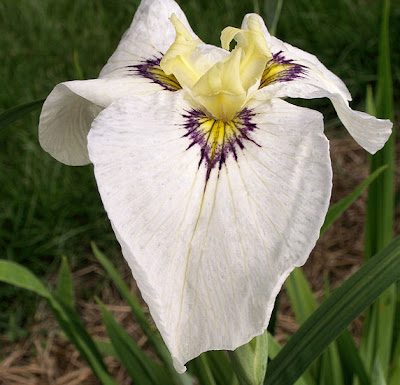

Photos courtesy
University of Georgia Atlanta
The first time I saw the Fringe Tree was at a Rose Society meeting. This of course was before I had surrendered to blackspot. A woman brought it to make an arrangement that included the tree. The whites blooms looked like fringes of lace and I decided at some point I had to grow it.
Years later, I found a 3 foot Chinese variety, as opposed to our American native variety, in a 2 gallon pot at Arbor Village Nursery in Holt, select key Missouri. I planted it to close to a window that it looked great for about three years. I had to give it up when we moved to a ranch dueto my spinal cord injury.
I went back to Arbor Village, and this time through their catalogue. It was really nothing more than a stick and with limited garden space I had to put it in a cramped location. It grew too large very quickly and I had to move it last summer. Anyway, it didn't make it through the winter so I went in search of another one. Last wee fringe, one of my best friends and I traveled Skinners Garden Center in Topeka, Kansas, which was the only place I could find any dwarf white redbud. I was so impressed with the quality of their material, I decided to head back there for a day nether fringe tree. I was not disappointed. They had a both American and Chinese and five and 10 gallons and 1 1/2 caliper trees. At the 10 gallon Bush style for about 150 bucks. The the 1 1/2 caliper was 180 and I didn't think my wife would go for that. But when I came home she was like why did you spend the extra 50 bucks to get a tree. So I am trying to figure a way to get my went back to the Topeka and bring back the larger size in a pickup truck.
I was helped by Aaron in their shrub and tree department. He had done some on-the-job training at Gage Park in Topeka he told me there are some mature trees in the park so I can't meet to check them out when they bloom next spring. He also Said that the birds like the black berries that come in the summer. He said that they were responsible for seedlings in the park.
Without a doubt, this is the most beautiful tree for the Midwest. Go check it out.
 I lived in St. Louis for about three years. On "The Hill", known for its fantastic Italian restaurants, is surrounded by beautiful older homes. Most homes feature a statue of Mary front and center.
I lived in St. Louis for about three years. On "The Hill", known for its fantastic Italian restaurants, is surrounded by beautiful older homes. Most homes feature a statue of Mary front and center.









